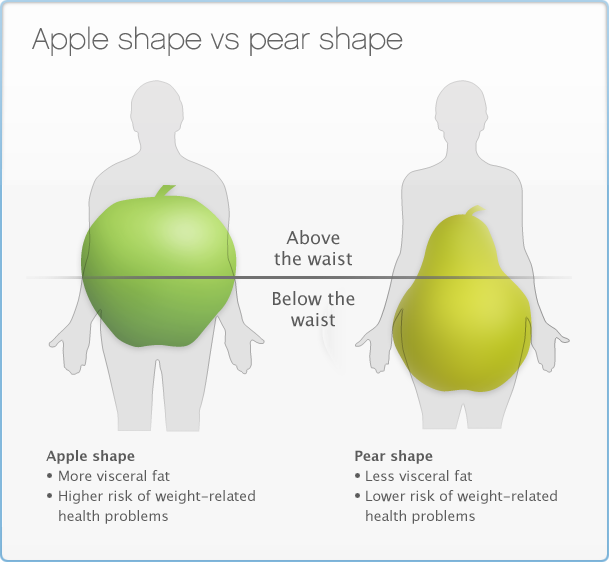Dr. Danesh D. Chinoy is a leading Health and Wellness Coach, Sports Physiotherapist and Psychologist. He is dedicated to helping all to heal holistically and remain fighting fit for life. Providing eye-opening and ground-breaking insights into Wellness, Dr. Chinoy’s two-decades’ rich expertise has won him innumerable awards, nationally and globally. His mission is to empower you to reach your highest levels of wellness/fitness. You can connect with Dr. Chinoy at: daneshchinoy@gmail.com
 A modest weight reduction of as little as 5% of body weight can reduce your high Blood Pressure and total cholesterol. However, simply knowing your weight isn’t enough to know your health risk. Did you know that despite having a healthy weight, you could still be at increased risk? Where you carry your weight is just as important as how much weight you carry, when it comes to your health. How your body stores excess weight (specifically fat) can negatively impact your health.
A modest weight reduction of as little as 5% of body weight can reduce your high Blood Pressure and total cholesterol. However, simply knowing your weight isn’t enough to know your health risk. Did you know that despite having a healthy weight, you could still be at increased risk? Where you carry your weight is just as important as how much weight you carry, when it comes to your health. How your body stores excess weight (specifically fat) can negatively impact your health.
A new consensus statement urges healthcare professionals to measure waist circumference in addition to the Body Mass Index (BMI) to manage a patient’s health and longevity, and avoid obesity-related health risks. Scientific studies prove that waist circumference is the strongest predictor of visceral fat (fat stored inside the abdominal cavity and around several vital organs), which poses the most significant health risk. I’ve always instructed my students to never rely on BMI (body Mass Index) alone in assessing obesity-linked health risks amongst patients. BMI can be misleading, particularly amongst our Indian population. The BMI, along with the waist circumference and the waist-to-hip ratio forms the trinity of obesity assessment – the ‘vital signs’ if you’re considering longevity and health.
Current scientific evidence strongly recommends that doctors and all health practitioners routinely monitor waist circumference to help determine whether lifestyle changes are working for patients. Lifestyle-induced reduction in waist circumference is associated with improvements in cardio-metabolic risk factors, with or without corresponding weight loss. So, remember, lifestyle changes affect the waist size and more importantly, your waist size dictates your lifestyle (and life itself!) eventually!
Look in the mirror – where your body tends to store fat can offer you a clue. If you’re an ‘apple’ – a big trunk and slimmer legs – it often can mean more visceral fat. This body shape is more common in men. Women’s body-shapes are more likely to be ‘pear’ – with bigger hips and thighs. Research shows that upper body fat is more dangerous to your health, which might be a reason why women usually live longer than men. Having an apple shape (carrying extra weight around the stomach) is riskier for your health than having a pear shape (carrying extra weight around your hips or thighs).
Why is abdominal fat such strong a marker of disease risk? Too much of any body fat is bad for health. But compared to the fat that lies just underneath your skin (subcutaneous fat), the visceral kind is more likely to raise your risk for serious medical issues. The fat surrounding the liver and other abdominal organs, so-called visceral fat, is very metabolically active. It releases fatty acids, inflammatory agents and hormones that ultimately lead to higher LDL cholesterol, triglycerides, blood glucose and blood pressure. Heart disease, Alzheimer’s, type 2 diabetes, stroke, and high cholesterol are some of the conditions that are strongly linked to too much fat in your trunk. Some studies show that visceral fat also produces more of certain proteins which inflame the body’s tissues and organs, narrowing your blood vessels, causing an increase in Blood Pressure, leading to a host of other problems.
Are you wondering what should be your ideal waist size? Different scientific institutions give different numbers – creating more confusions. It’s best to follow a general rule of thumb (based on science) – make sure your waist size is not more than half that of your height. For eg., if your height is 6 feet or 72 inches, your waist circumference should not be greater than 36 inches. Likewise, if your height is 5 feet 6 inches i.e., 66 inches, then your waist circumference should be less than 33 inches. This formula holds true for both genders. Reducing your waist circumference by just a couple of inches can have massive benefits to your risk profile and reduce your chances of developing diabetes, heart disease and stroke.
 The Waist-To-Hip ratio (WHR) is another simple, quick and useful measure of fat distribution that helps indicate overall health, considering the proportion of fat stored around your waist and hip. The WHR is calculated by dividing your waist measurement by your hip measurement (hips being the widest area including the buttocks). Hence, WHR = Waist Circumference / Hip Circumference. As per the World Health Organization, a WHR of over 1.0 increases the risk of developing conditions including heart diseases and type 2 diabetes. This may be the case, even if other measures of being overweight, such as BMI are in normal range. WHO advises that a healthy WHR is lesser than 0.85 for women and 0.9 for men.
The Waist-To-Hip ratio (WHR) is another simple, quick and useful measure of fat distribution that helps indicate overall health, considering the proportion of fat stored around your waist and hip. The WHR is calculated by dividing your waist measurement by your hip measurement (hips being the widest area including the buttocks). Hence, WHR = Waist Circumference / Hip Circumference. As per the World Health Organization, a WHR of over 1.0 increases the risk of developing conditions including heart diseases and type 2 diabetes. This may be the case, even if other measures of being overweight, such as BMI are in normal range. WHO advises that a healthy WHR is lesser than 0.85 for women and 0.9 for men.
We put on weight when we eat more energy (calories) than we burn, regularly putting more calories into our bodies than we use. Over time, that extra energy is stored as fat. Today the oversize problem is a direct result of wrong food choices, rather than the amount of food consumed. Exercise helps you shed both – visceral fat and subcutaneous fat you can see and pinch. If you lose weight through diet, exercise can help you keep it off.
Every bit helps. Go for walks after dinner. Take the stairs. Use a bicycle instead of a motorcycle. Aim for at least 30 minutes of moderate aerobic exercise daily. It’s also important to keep and to build muscles. Work out with weights, do resistance training like push-ups and sit-ups, and practice yoga. Refer to my articles on food and exercise choices that would slowly but surely put you on the road to your well-being. Mind your waist to prevent your waste!
Do keep writing in with your questions and suggestions. God bless!
- The Healing Power Of ‘Shinrin-Yoku’ (Forest Bathing) - 28 December2024
- The Incomparable Health Benefits Of Plant-Based Diet - 30 November2024
- The Role Of Physiotherapy In Mental Health: A Holistic Approach - 28 September2024
